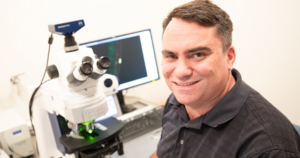A rare disorder called Timothy syndrome causes severe heart malfunction, and most people diagnosed with it don’t survive beyond childhood. It is caused by a single gene variant that can also cause autism, so it provides a unique window into autism at the genetic level.
Autism is a neurological and developmental disorder associated with variants in at least 1,000 genes. But scientists still don’t know how these variants contribute to the development of autism in people.
It would help if scientists could peer into the developing human brain, watch its cells form connections and see how autism affects that process. In lieu of that, Christopher Quinn, an associate professor of biological sciences, has found an effective way to study what happens when brain connections go awry.
Quinn and his lab team are getting help from a worm called C. elegans. It has about 1,000 cells and 300 neurons – relatively few compared with other animals or with humans – so the team knows exactly how the neurons should connect to one another.
Moreover, they can look through a microscope and get a glimpse of the worms’ communication pathways. When those pathways are altered, they can see it right in front of them on a microscope slide. That’s where the unique features of Timothy syndrome take on added importance.
Because the syndrome is caused by a variant in a single gene related to autism – called CACNA1C – and C. elegans has so few neurons, scientists can get a clear cause-and-effect picture when the gene variant is introduced to the worm.
Brain cells have axons, which send signals, and dendrites, which receive signals. Quinn’s team found that the gene variant in the worms disrupted axon targeting – and thus affected where neurons were connecting.
“An axon is a long structure that makes connections with other neurons,” Quinn says. “What we found is that in the worms carrying the genetic variant, axons connect to the same neurons that they normally do, but in the wrong location.”
Their research, published in PLoS Genetics, found that the Timothy syndrome variant also changed the worms’ behavior, and it was measurable.
Quinn’s team, which is funded by a $1.7 million grant from the National Institute of Mental Health, is also working on how other variants in the CACNA1C gene affect the risk of autism. As many as a third of people have one of the autism-associated variants of this gene, but most don’t develop autism. It’s the interactions of a whole group of genetic variants that determine if a person develops autism.
“That’s why we want to understand the genetic interactions,” Quinn says. “If we understand all these interactions, then through whole genome sequencing, you might be able to predict who is most likely to develop autism and provide earlier treatment that will lead to better outcomes for these children.”
By Becky Lang, University Relations
